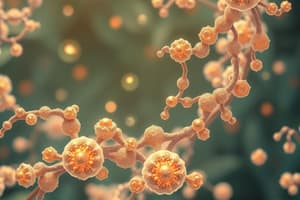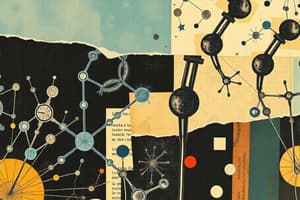Podcast
Questions and Answers
Which of the following is NOT a major class of biomolecules?
Which of the following is NOT a major class of biomolecules?
- Carbohydrates
- Minerals (correct)
- Lipids
- Proteins
Catabolism involves the synthesis of complex molecules from simpler ones.
Catabolism involves the synthesis of complex molecules from simpler ones.
False (B)
What is the primary function of DNA?
What is the primary function of DNA?
Storing genetic information
Enzymes act as biological ______ by speeding up reactions.
Enzymes act as biological ______ by speeding up reactions.
Which of the following best describes the role of lipids?
Which of the following best describes the role of lipids?
Enzyme activity is unaffected by changes in temperature and pH.
Enzyme activity is unaffected by changes in temperature and pH.
Match the biomolecule with its function:
Match the biomolecule with its function:
Which of the following is an example of a protein with a transport function?
Which of the following is an example of a protein with a transport function?
What structure of proteins refers to the overall 3D shape of the polypeptide chain?
What structure of proteins refers to the overall 3D shape of the polypeptide chain?
RNA contains thymine as one of its nitrogenous bases.
RNA contains thymine as one of its nitrogenous bases.
What is the primary source of energy for the body?
What is the primary source of energy for the body?
The process of breaking down glucose to pyruvate while producing ATP is called ______.
The process of breaking down glucose to pyruvate while producing ATP is called ______.
Match the following metabolic processes with their functions:
Match the following metabolic processes with their functions:
Which component plays a critical role in cellular respiration?
Which component plays a critical role in cellular respiration?
Cell signaling involves only external signals received by a cell.
Cell signaling involves only external signals received by a cell.
What is the role of feedback mechanisms in biochemical processes?
What is the role of feedback mechanisms in biochemical processes?
Flashcards
What is Biochemistry?
What is Biochemistry?
The study of the chemical processes occurring within and relating to living organisms.
What are biomolecules?
What are biomolecules?
Fundamental building blocks of life, made from carbon, hydrogen, oxygen, nitrogen, phosphorus and sometimes sulfur.
What are the four major classes of biomolecules?
What are the four major classes of biomolecules?
The four major classes of biomolecules are carbohydrates, lipids, proteins, and nucleic acids.
What is catabolism?
What is catabolism?
Signup and view all the flashcards
What is anabolism?
What is anabolism?
Signup and view all the flashcards
What are enzymes?
What are enzymes?
Signup and view all the flashcards
What are some examples of protein functions?
What are some examples of protein functions?
Signup and view all the flashcards
What are some characteristics of enzymes?
What are some characteristics of enzymes?
Signup and view all the flashcards
Primary structure
Primary structure
Signup and view all the flashcards
Secondary structure
Secondary structure
Signup and view all the flashcards
Tertiary structure
Tertiary structure
Signup and view all the flashcards
Quaternary structure
Quaternary structure
Signup and view all the flashcards
Glycolysis
Glycolysis
Signup and view all the flashcards
Gluconeogenesis
Gluconeogenesis
Signup and view all the flashcards
Glycogenolysis
Glycogenolysis
Signup and view all the flashcards
Lipogenesis
Lipogenesis
Signup and view all the flashcards
Study Notes
Introduction to Biochemistry
- Biochemistry is the study of the chemical processes within and relating to living organisms.
- It encompasses a wide range of topics, including the structure and function of biomolecules, metabolic pathways, and the regulation of these processes.
- Biochemistry plays a crucial role in understanding health, disease, and the development of new therapies.
Biomolecules
- Biomolecules are the fundamental building blocks of all living organisms.
- Four major classes: carbohydrates, lipids, proteins, and nucleic acids.
- Carbohydrates: primarily composed of carbon, hydrogen, and oxygen; provide energy and structural support. Subclasses include monosaccharides, disaccharides, and polysaccharides.
- Lipids: diverse group of hydrophobic molecules, including fats, oils, and steroids; crucial for energy storage, insulation, and membrane structure. Examples include triglycerides, phospholipids, and cholesterol.
- Proteins: polymers of amino acids; crucial for diverse functions in the body, including catalysis (enzymes), transport, and structural support. Structure is complex; primary, secondary, tertiary and quaternary structures.
- Nucleic Acids: deoxyribonucleic acid (DNA) and ribonucleic acid (RNA); carry genetic information and are essential for protein synthesis. DNA stores genetic information, while RNA translates this information.
Cellular Metabolism
- Cellular metabolism encompasses all the biochemical reactions occurring within a cell.
- Two major types:
- Catabolism: the breakdown of complex molecules into simpler ones, releasing energy.
- Anabolism: the synthesis of complex molecules from simpler ones, requiring energy input.
- Key metabolic pathways, including glycolysis, the citric acid cycle, and oxidative phosphorylation, which are central to energy production.
- Regulation of metabolic pathways is critical for maintaining homeostasis.
Enzymes
- Enzymes are biological catalysts, typically proteins, accelerating biochemical reactions without being consumed.
- They work by lowering the activation energy of a reaction, facilitating the conversion of substrates to products.
- Characteristics of enzymes include specificity, sensitivity to environmental factors (e.g., temperature, pH), and regulation.
Protein Structure and Function
- Proteins have diverse roles, including structural support (collagen), transporting molecules (hemoglobin), catalyzing reactions (enzymes), and signaling (hormones).
- Primary structure: amino acid sequence.
- Secondary structure: localized folding patterns (α-helices, β-sheets).
- Tertiary structure: overall 3D shape of the polypeptide chain, stabilized by various interactions.
- Quaternary structure: arrangement of multiple polypeptide chains in a functional protein.
Nucleic Acids
- DNA carries genetic information.
- RNA plays a vital role in protein synthesis.
- DNA structure: double helix composed of nucleotides, each with a sugar, a phosphate group, and a nitrogenous base. DNA bases are adenine, guanine, cytosine, and thymine.
- RNA structure: single-stranded, containing nucleotides with a different sugar (ribose) and uracil instead of thymine.
Carbohydrate Metabolism
- Carbohydrates are the primary source of energy for the body.
- Glucose is a key metabolic substrate.
- Glycolysis: the breakdown of glucose to pyruvate, producing ATP.
- Gluconeogenesis: the synthesis of glucose from non-carbohydrate precursors.
- Glycogenolysis: breakdown of glycogen to glucose.
Lipid Metabolism
- Lipids store energy, form membranes, and act as hormones.
- Fatty acid oxidation: a key metabolic pathway for energy production.
- Lipogenesis: synthesis of fatty acids.
Cellular Respiration
- Cellular respiration is a series of metabolic reactions that convert nutrients into usable energy (ATP).
- Occurs in the mitochondria.
- It proceeds through various stages, including glycolysis, the Krebs cycle/Citric Acid cycle, and oxidative phosphorylation.
Cell Signaling
- Cells communicate with each other through various pathways.
- Signaling pathways involve cascades of biochemical reactions, often involving protein-protein interactions.
- Key components include receptors, intracellular signaling molecules, and effectors.
Regulation of Biochemical Processes
- Many of these processes are highly regulated to maintain homeostasis.
- Regulation often occurs at the level of enzyme activity or gene expression.
- Feedback mechanisms are crucial for maintaining balance.
Studying That Suits You
Use AI to generate personalized quizzes and flashcards to suit your learning preferences.




